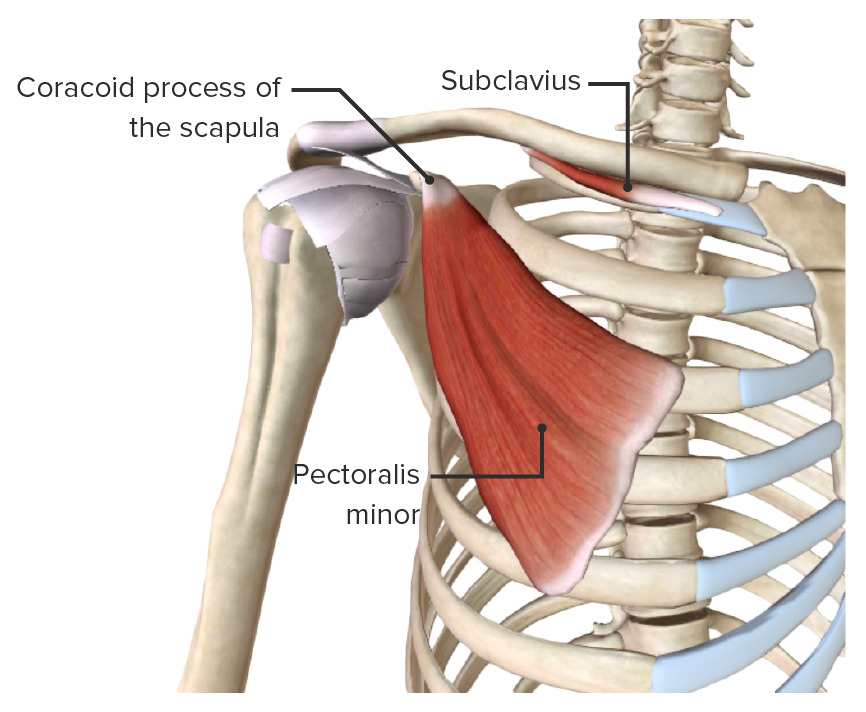Playlist
Show Playlist
Hide Playlist
Scapula – Bones and Surface Anatomy of Upper Limb
-
Slides 01 UpperLimbAnatomy Pickering.pdf
-
Download Lecture Overview
00:01
If we now move on to the
scapula. The scapula
is connected to the sternum by way of the
clavicle. And we can see here we have numerous
of views of a scapula. Here we've got a posterior
view, here we've got a lateral view, the middle
picture on this slide. And here we can see
we have got an anterior view. We can see here
on this side of the screen. So let's look
at some features of the scapula.
00:30
As I mentioned it's a triangular, it's a flat
bone and it sits on the posterolateral
aspect of the thorax at the level of ribs
2-7. So it sits directly posterior to the
rib cage at the level of ribs 2-7. The posterior
surface which we can see here is divided by
this prominent ridge. This is known as the
spine of the scapula. We can see it dilates
into this large structure here known as the
acromion. But the spine separates the posterior
surface of the scapula into a supraspinous.
So supraspinous above the spine and infraspinous
fossa. We have a supraspinous and infraspinous
fossa and these fossae are important in offering
muscle attachment that work on the shoulder
joint and again we'll look at this in more detail.
01:27
So the posterior surface has this prominent
spine, this ridge forming a supraspinous and
infraspinous fossa. On the anterior surface
it's quite featureless really but we just
have a fossa again for subscapularis muscle
and this fossa is known as the subscapular
fossa which we can see here on this anterior
surface. So the subscapularis muscle which
we will cover in few lectures time is sitting
directly between the ribs and the scapula.
02:04
So some more features. We have what are known
as angles on the scapula. We have three angles.
02:12
We have a superior, an inferior and a
lateral angle. So let's just orientate ourselves.
02:17
This is at the top on the posterior view. So we
have a superior angle. The superior angle
is connected to this inferior angle via this
medial border. We can see this medial border
of the scapula here. We have got a superior
angle, this tip and we have got an inferior
angle here. And these two are connected by
way of this medial border. We also have a
lateral angle here and that forms the three
points of this triangle-shaped scapula.
02:49
The superior angle is connected to the lateral
angle by way of this superior border and the
lateral angle is connected to the inferior angle
by way of this lateral border. So on the
scapula, we have these three angles, superior,
inferior and lateral. And these are connected
via borders, medial, lateral and superior borders.
And we can see these on the screen.
03:17
Superior angle, inferior angle, lateral angle.
Medial border, lateral border, superior border.
03:27
And let’s have a look at a few more features that we
can see. First of all, on this lateral border,
we can see here, we have a neck of the scapula.
So this narrowing where the superior border
and the lateral border began to converge we
have a neck and then we have a head, the head
of the scapula. And this is characterized by a
depression which is known as the glenoid cavity
and that is going to articulate with the
head of the humerus forming the shoulder joint
of the glenohumeral joint. So we can see we
have got the glenoid cavity here forming the
head really and just medial to it we have
the neck of the scapula along this lateral
border. The superior border here we have an
important feature and this is known as the
suprascapular notch. The suprascapular notch
is important as it allows the blood vessel
to pass through over the top of the scapula
and we will come to that in due course
in some later lectures. So here we
can see various features which
we can see on this posterior view. We can
see if we look at the anterior view we can
again see we have got this neck of the
scapula and we have got a head of the scapula
forming the glenoid cavity and we can see
the suprascapular notch. If we look at the
spine, so let's just concentrate on the spine
of the scapula there we can see starting
medially from this medial border and as it travels
laterally and it actually gets bigger and
bigger until it forms this dilated bulge which
is known as the acromion. And we can see this
here on the posterior view. We can see it's
prominently passing more laterally than the
actual main body of the scapula. And we can
see the acromion here on this anterior view.
05:17
And here on this lateral view, which as if you're looking
from the lateral aspect, we can see we have
got this costal surface. So this is the anterior
surface sitting against the ribs and this
is the posterior surface here, so it have skin
along here. Here we can see the glenoid cavity
and then radiating up here we have got the acromion.
We can see it's almost running completely
over the glenoid cavity and that is important
as we come to realize because it can help to
prevent superior dislocation of the humerus.
So we have got the acromion and remember in
a few slides previously we have the clavicular
acromial ligament where the ligament attaching
from the acromion to the clavicle.
We will come back to that. So we have got
the spine here of the scapula and that articulates
with the clavicle. If we look at the head
in a bit more detail then we have got the glenoid
cavity. We can also see if we look clearly
here with this lateral view, here is the glenoid
cavity. We can also see if we look clearly
here with this lateral view, here is the glenoid
cavity. We can see we have got a supraglenoid
and an infraglenoid tubercle. So small little
elevations, it's all bony masses on the superior
and inferior aspects of the glenoid cavity
and these are important for muscle attachment
as we will see both long head of biceps and
triceps attached to the superior and infraglenoid
tubercles respectively. So here we have got the glenoid
cavity, and a supra and infraglenoid tubercles.
06:52
We will come back to these later on. The
final feature I want to talk about is
the coracoid process here and this is an important
kind of bulge again coming up from the superior
border and from the head of the scapula. And this
is the coracoid process. Again it helps to
form the muscle attachments we will talk about
coracobrachialis in a few slides time and
we can see here the coracoid process. Here
again on the lateral view we can see coracoid
process and here on this anterior view we can
see again the coracoid process. So some important
features here on the scapula.
About the Lecture
The lecture Scapula – Bones and Surface Anatomy of Upper Limb by James Pickering, PhD is from the course Upper Limb Anatomy [Archive].
Included Quiz Questions
Which of the following statements regarding scapula is correct? Select all that apply.
- The coracoid process is located on the lateral aspect of the superior border of the scapula.
- The glenoid cavity articulates with the clavicle.
- The glenohumeral joint is an articulation between the head of the humerus and a specialized region of the scapula.
- The posterior surface is the subscapular fossa.
At which thoracic rib level is the scapula located?
- 2–7
- 1–7
- 3–7
- 4–7
- 1–5
Which border connects the superior angle of the scapula with the inferior angle?
- Medial
- Lateral
- Superior
- Posterior
- Inferior
Which dislocation of the humerus does the acromion prevent?
- Superior
- Anterior
- Posterior
- Inferior
- Lateral
The fossa on the anterior surface of the scapula provides attachment to which muscle(s)?
- Subscapularis
- Supraspinatus
- Infraspinatus
- External intercostal muscles
- Brachioradialis
Customer reviews
4,5 of 5 stars
| 5 Stars |
|
1 |
| 4 Stars |
|
1 |
| 3 Stars |
|
0 |
| 2 Stars |
|
0 |
| 1 Star |
|
0 |
Helped me a TON! Great quick easy overview of the Scapular bone, and was much easier to learn and understnad throughout this video. Much better understandment than my antomy class.
I certainly liked the video format, where we can adjust the focus from the speaker to the slide, and use the cursor to aid in pinpointing the relevant aspects of the scapula. The only thing I found was missing was a little aside about the suprascapular notch, which was shown in the slide, but not alluded to in the actual video lecture!




